SCIENCE REPORTER SUMMARY: JUNE 2024
Article 1:
- ARTICLE 2:
- ARTICLE 3:
- ARTICLE 4
- ARTICLE 5
- ARTICLE 6
- ARTICLE 7
- ARTICLE 8
- ARTICLE 9
- ARTICLE 10
- ARTICLE 11:
- ARTICLE 12
- NEWS IN BRIEF
- 1) India’s first mobile Medical Devices Calibration facility
- 2) IIT Guwahati Pioneers Groundbreaking Speech Reconstruction Technology
- 3) New plastic coating discovery gives greater functionality to 3D printing
- 4) Sodium Battery — Charges in Just a Few Seconds
Nitroplast: A New Entrant to the Organelle Club:
Discovery of Nitroplast: A New Organelle

- Recent publications in Science (April 2024) and Cell (March 2024) have presented groundbreaking evidence that a nitrogen-fixing cyanobacterium, Candidatus Atelocyanobacterium thalassa (UCYN-A), living symbiotically inside the marine alga Braarudosphaera bigelowii, has evolved into a new organelle named Nitroplast.
- Tyler Coale, one of the authors, highlights that Nitroplast is the first known nitrogen-fixing organelle and could be vital to the success of these algae.
- This alga, hosting the Nitroplast, is widely distributed in oceans globally. The discovery is a significant breakthrough with potential applications in agriculture.
Evolutionary Significance and Endosymbiosis
- Life on Earth began around 3.5 billion years ago with simple unicellular organisms, which evolved into complex life forms over millions of years through mutations and genetic changes.
- Evolution sometimes involves endosymbiosis, where one organism lives inside another, leading to novel life forms. Endosymbiotic relationships typically involve distinct domains of life, where partners retain independent survival abilities.
- In rare cases, endosymbionts integrate into host cells, forming inseparable organelles.
- Notable examples include mitochondria, chloroplasts, and chromatophores. Nitroplast, as a nitrogen-fixing organelle, may join these ranks.
The Role of Nitrogen in Life:
- Nitrogen is essential for life, forming crucial biomolecules like proteins and nucleic acids. Despite its abundance in the atmosphere (78%), nitrogen is inert and requires significant energy to convert into usable forms like ammonia.
- Nitrogen-fixing microorganisms evolved to perform this conversion, providing organic nitrogen in biomass and nitrates in soil and water.
- Some plants, like legumes, and marine algae engage in endosymbiotic relationships with nitrogen-fixing organisms to meet their nitrogen needs.
UCYN-A and Braarudosphaera bigelowii: A Symbiotic Relationship
- The symbiotic relationship between B. bigelowii and UCYN-A has been known for years. The cyanobacterium, unable to photosynthesize, depends on the alga for carbon compounds, while the alga relies on the bacterium for nitrogen fixation.
- Speculations about UCYN-A transforming into an organelle, Nitroplast, have existed, but concrete evidence was lacking.
- The challenge of cultivating B. bigelowii in the lab was overcome by Kyoko Hagino of Kochi University, enabling further study.
Evidence of Nitroplast Formation
Prof. Jonathan Zehr and his international team at the University of California, Santa Cruz, provided evidence that the merger between B. bigelowii and UCYN-A led to the formation of Nitroplast.
Key features indicating complete integration include:

- Genomic Shrinkage: The genome of UCYN-A (Nitroplast) has reduced, losing several essential genes.
- Cell Division Coordination: 3D subcellular images using X-ray tomography showed synchronized division of Nitroplasts and algal cells, passing Nitroplasts to daughter cells like other organelles.
- Protein Dependence: Nitroplasts rely on proteins encoded by the algal nuclear genome, synthesized in the cytoplasm, and directed to Nitroplasts via specific transport peptides. 28% of Nitroplast proteins, including those for nitrogen fixation, originate from the host alga.
Agricultural Implications
- The discovery of Nitroplast has significant agricultural implications. Crop yields are often limited by the availability of usable nitrogen, making nitrogen fertilizers essential.
- Understanding algal Nitroplasts could lead to technology enabling plants to possess nitrogen-fixing organelles, reducing reliance on fertilizers. While this goal is distant, the potential benefits are substantial.
ARTICLE 2:
Leap toward Carbon Neutrality CO₂ to Methanol
Cobalt Phthalocyanine: A Breakthrough Catalyst
- Researchers at the University of Michigan have developed a catalyst known as cobalt phthalocyanine, capable of converting carbon dioxide (CO₂) into renewable fuels like methanol.
- This advancement, detailed in the journal ACS Catalysis, demonstrates a sustainable method for reducing greenhouse gas emissions and producing clean energy.
- The conversion process involves multiple reaction steps: the initial transformation of CO₂ into carbon monoxide (CO), followed by the conversion of CO into methanol.
Addressing a Long-standing Challenge
- Scientists have long sought to chemically convert CO₂ into methanol, which could be used as an environmentally friendly fuel for vehicles.
- Despite the industrialization of CO₂-to-methanol conversion, achieving this transformation on a large scale through electrochemical processes has remained a significant challenge.
- The University of Michigan team’s approach is unique, integrating insights from various scientific and engineering fields to design and understand the system optimally.
Mechanism of Cobalt Phthalocyanine
- Cobalt phthalocyanine acts as a molecular hook for CO₂ or CO molecules. The geometry of molecules around the cobalt metal is crucial, as it determines the binding strength of each gas molecule.
- The researchers discovered that cobalt phthalocyanine binds much more strongly to CO₂ molecules than to CO molecules.
- Consequently, once CO is produced in the first step, it is quickly displaced by another CO₂ molecule before it can be converted to methanol.
Computational and Experimental Insights
- Using advanced computational modeling, the researchers calculated that cobalt phthalocyanine binds CO₂ over three times more tightly than CO.
- This finding was confirmed through experiments measuring reaction rates with varying amounts of CO₂ and CO.
- The difference in binding affinity is linked to how the catalyst’s electrons interact with the CO₂ and CO molecules.
Future Directions
- To overcome this binding issue, the researchers propose redesigning the cobalt phthalocyanine catalyst to strengthen its interaction with CO and reduce its affinity for CO₂.
- Solving this problem could enable the efficient large-scale conversion of CO₂ waste into methanol fuel, making cobalt phthalocyanine a pivotal catalyst in the fight against climate change.
ARTICLE 3:
IIT Madras researchers identify the Indian Ocean & Bay of Bengal as Potential CO₂ sinks that decarbonize industrial clusters
CO₂ Sequestration in the Indian Ocean and Bay of Bengal
- Researchers at the Indian Institute of Technology Madras (IIT Madras) have identified the Indian Ocean and Bay of Bengal as potential storage sinks for carbon dioxide (CO₂), offering a promising solution for decarbonizing industrial clusters.
- This process, known as CO₂ sequestration, involves storing CO₂ in the ocean as a solid hydrate beyond 500 meters of sea depth, helping to achieve carbon neutrality for industrial areas.
- This method could help India meet its national decarbonization and climate change goals by leveraging the ocean’s capacity to store CO₂ without harming marine ecology.
Creating Eco-friendly Gas Hydrates
- The research reveals that CO₂ can be stored permanently in the ocean as an ice-like substance called gas hydrates.
- One cubic meter of gas hydrate can sequester approximately 150-170 cubic meters of CO₂ under oceanic conditions beyond 500 meters depth.
- This method has significant potential to decarbonize India’s industrial clusters and paves the way for large-scale CO₂ storage in subsea sediments, contributing to India’s net-zero targets.
Mechanism and Benefits of Deep-sea Storage
- Experts from IIT Madras explains that methane hydrates have existed in the ocean for millions of years without environmental impact.
- Methane, being a more potent greenhouse gas than CO₂, encourages researchers to explore the ocean for permanent CO₂ storage.
- At depths above 2,800 meters, CO₂ becomes denser than seawater, creating an additional gravitational barrier that prevents its escape.
- This finding highlights the potential for using deep-sea storage to capture and sequester CO₂ safely.
Potential for Large-scale Sequestration
- India’s dependence on fossil fuels necessitates CO₂ capture and sequestration to achieve net-zero goals.
- The Bay of Bengal alone could sequester several hundred gigatonnes of anthropogenic CO₂, equivalent to several years of India’s total greenhouse gas emissions.
- countries like Norway and Denmark are already exploring CO₂ storage in the North Sea, demonstrating the feasibility of this approach.
Stabilizing Gas Hydrates with Subsea Sediments
- The research team found that once CO₂ is stored as a gas hydrate, it remains trapped due to the gravitational and hydrate permeability barriers in subsea sediments.
- The presence of clay in these sediments enhances the mechanical and thermal stability of gas hydrates, ensuring long-term CO₂ storage. Higher clay concentrations improve the kinetics of hydrate formation, making the storage process more efficient and stable.
Enhancing Hydrate Formation with Additives
- Research scholars emphasize the importance of storing CO₂ at sufficient depths to minimize environmental impact.
- Storing CO₂ in subsea sediments reduces its impact on marine life, as these sediments have tiny spaces that can hold CO₂, forming ice-like gas hydrate crystals over time.
- Additives like Tetrahydrofuran (THF) can further enhance hydrate formation, making large-scale CO₂ storage in subsea sediments more feasible.
Future Directions for CO₂ Storage
- The IIT Madras team suggests that studying the concentration of clay, properties of additives, and local bathymetry information can help optimize CO₂ storage in subsea sediments.
- This research provides a framework for developing effective CO₂ sequestration strategies, contributing to global efforts to mitigate climate change.
ARTICLE 4
Exploring the Ocean Depths with C-Bot

The Magnificent Oceans
- Oceans are truly magnificent; they can be chaotic and agitated at times, yet beneath the surface, they are always serene. Their depths hold many treasure troves of knowledge waiting to be discovered.
- Life on Earth, as we know it, might have crawled onto the surface of Earth from the vast depths of these oceans over 4 billion years ago.
- Known as the “Primordial Soup” hypothesis, it suggests that the early Earth’s oceans, rich in essential chemicals and minerals, provided the perfect environment for the formation of organic molecules.
- Over millions of years, these molecules evolved into the first simple life forms, thriving in nutrient-rich waters.
- From these humble beginnings, life gradually diversified and adapted to various environments, eventually spreading to land and air. Even today, the oceans remain teeming with diverse life forms.
The Significance of Ocean Exploration
- The significance of ocean exploration in human history is profound, given that the ocean covers 71% of the Earth’s surface and is an essential source of resources.
- Oceans facilitate invaluable contributions to trade, scientific breakthroughs, and discoveries, albeit with a shadowy history of colonization and exploitation.
- Iconic tales from the history of ocean exploration include the Voyages of Christopher Columbus in 1492, Vasco da Gama’s Sea Route to India in 1498, Magellan’s Circumnavigation in 1519, and The Challenger Expedition from 1872 to 1876.
- These expeditions mark a few prominent events in the history of ocean exploration, most of which were conducted on the surface due to the lack of equipment and technology.
- Notable accomplishments in underwater exploration, such as the use of diving belts in the 4th century BCE and Jacques Cousteau’s development of the Aqua-Lung in 1943, have significantly expanded our understanding of the oceans.
Unlocking the Mysteries of the Deep Sea
- Underwater explorations are crucial in expanding our understanding of the world’s oceans and their significance for life on Earth.
- Despite covering over 71% of the Earth’s surface, a vast cavern of the unknown lies dormant on the seafloor.
- Underwater explorations provide an opportunity to unlock the mysteries of the deep sea, revealing new species, geological formations, and ecosystems that are yet to be documented.
- By conducting underwater explorations, scientists can gain insights into fundamental processes such as ocean circulation, marine biology, and geology, contributing to our understanding of Earth’s interconnected systems.
- Understanding underwater ecosystems is essential for effective environmental conservation, as studying marine habitats and species helps identify areas of ecological importance, assess human impacts, and develop strategies for conservation and restoration.
The Importance of Coral Reefs
- Oceans hold numerous biological hotspots, with coral reefs being among the most intriguing and mesmerizing to study.
- Coral reefs, brimming with marine life, form through a fascinating process of coral calcification.
- Starting as tiny free-swimming coral larvae, these larvae drift with ocean currents until they find a suitable location to settle, developing into polyps that form colonies through asexual reproduction.
- Over thousands of years, these colonies grow into vast structures known as coral reefs, contributing to intricate ecosystems supporting a wide range of marine life.
- Coral reefs are crucial for coastal protection, global biodiversity, and supporting local economies and livelihoods.
- They act as natural barriers, protecting coastal communities from storms and erosion, and play a role in global carbon cycling and climate regulation.
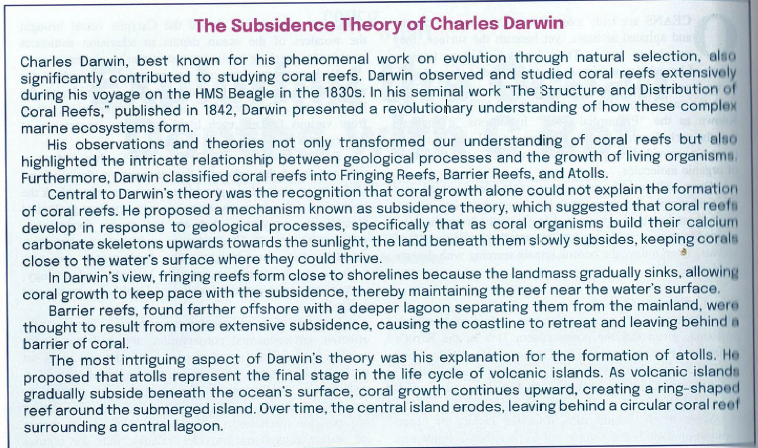
Coral Reef Conservation Efforts
- Despite their vibrant ecosystems, coral reefs are incredibly fragile. Human interventions, such as coastal development, pollution, and unsustainable tourism, harm coral reefs by damaging their structure and disrupting marine ecosystems.
- Environmental stressors like ocean acidification, increased storm intensity, and sedimentation further compound these challenges.
- Coral bleaching, where corals expel symbiotic algae due to stress, poses a significant threat to coral reefs and the species that rely on them.
- Amid growing concerns, scientists are innovating new technologies for coral conservation, such as the Coral Monitoring Robot (C-Bot) developed by the CSIR-National Institute of Oceanography (CSIR-NIO) in Goa.
- This indigenous technology aims to provide invaluable insights into coral reef ecosystems, aiding marine scientists in understanding and addressing their challenges better.

The Future of Underwater Exploration
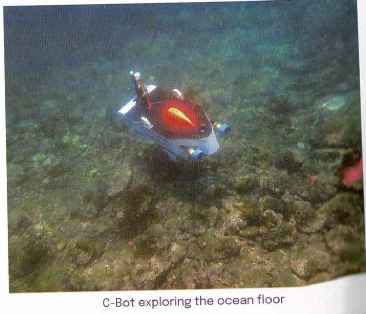
- As technology evolves, underwater robotics like the C-Bot are set to revolutionize marine exploration.
- Initially designed for coral monitoring, the C-Bot’s adaptability allows it to perform various tasks, from pipeline inspections to underwater surveillance. Its advanced sensor technology and autonomy enable it to collect detailed data, enhancing our understanding of marine environments.
- Despite logistical challenges in expanding its capabilities for deeper ocean realms, the C-Bot represents a significant advancement in Indian marine research technology.
- Its role in coral monitoring and potential for multifaceted applications underscore its importance in advancing marine research and conservation efforts.
ARTICLE 5
Oceanography and Marine Geology in India
The Oceans and Their Captivation
- The oceans and seas have always fascinated humanity with their abundant natural resources and diverse marine life.
- Our ancestors were amazed by their varying moods, including tidal variations, waves, currents, sand transport, and the mixing of fresh river waters.
- This curiosity led to explorations aimed at understanding more about the oceans and weather.
- Navigators measured the depths of shallow seas and understood the nature of the sea bottom to avoid getting stranded and to find anchorage sites and fishing grounds.
The Study of Oceans: Oceanography
- The study of oceans has been known by various names, including maritime science, maritime geography, marine science, physical geography of the sea, tidology, oceanology, and thalassography.
- However, the term “oceanography” became widely accepted as a broad field with four major branches: Biology, Geology, Chemistry, and Physics, each focusing on different aspects of the oceans.
- Allied fields include Marine Instrumentation, Satellite Oceanography, Ocean Engineering, Marine Archaeology, Maritime Education, Ocean Policy, and Laws.
Oceanography in India: Historical Beginnings
- Scientific studies of tides, seas, and oceans began globally in the 2nd century BC, supported by governments, scientific societies, corporations, and royal families. In India, oceanography started much later and was wholly funded by the Government of India (GoI).
- In 1871, the Council of the Asiatic Society of Bengal (CASB) proposed conducting and supporting expeditions in the Indian Ocean, Arabian Sea, and Bay of Bengal, with support from the Royal Society of London and approval from the GoI. However, research vessels for surveys were lacking.
- In 1872, the Indian Museum sponsored its curator, James Wood-Mason, to conduct the first survey onboard “SS Undaunted” in the Andaman Sea.
- Despite ship limitations, significant work in bathymetry, biology, and geological observations was conducted. In 1874, the GoI founded the Marine Survey of India (MSI), and by 1878, they acquired equipment from the decommissioned HMS Challenger.
- The Royal Indian Marine Survey Ship Investigator (RIMSS Investigator) was launched in 1881, marking a significant milestone in Indian oceanographic studies.
Early Surveys and Challenges
- From 1884 to 1892, surveys covered various regions, including the mouth of the Hooghly River, coasts of Chittagong, Madras, Porbandar, and Laccadive Islands.
- AW Alcock’s innovations in depth measurements and dredging significantly improved sample collection.
- Between 1873 and 1957, the Indian Ocean was explored using 24 vessels, leading to important observations about monsoon and nutrient-rich bottom waters.
- The formation of the Scientific Committee on Oceanic Research (SCOR) in 1957 facilitated international scientific cooperation, leading to the International Indian Ocean Expedition (IIOE-1) from 1959 to 1965, with significant Indian participation.
Modern Indian Oceanographic Studies
- India’s oceanographic studies expanded significantly with international collaborations.
- The International Geophysical Year (IGY 1957-58) saw collaborations between Indian and foreign scientists, leading to the understanding of mid-ocean ridges and seafloor spreading.
- The IIOE-1 involved 20 countries, and India’s National Institute of Oceanography (CSIR-NIO) was founded in 1966.
- The International Indian Ocean Expedition (IIOE-2) from 2015 to 2020 addressed new and old research questions about the Indian Ocean.
International Oceanographic Programs
- India participated in various international oceanographic programs like InterRidge, the Deep Sea Drilling Project, and the Integrated Ocean Drilling Programme (IODP).
- The IODP, coordinated by the Ministry of Earth Science (MoES) through the National Centre for Polar and Ocean Research (NCPOR), Goa, explored areas like the Sumatra seismogenic zone and the Bengal Fan.
- The GEOTRACES project and the Geochemical Ocean Sections Study (GEOSECS) contributed to understanding trace metal cycling and ocean chemistry.
Polar Expeditions
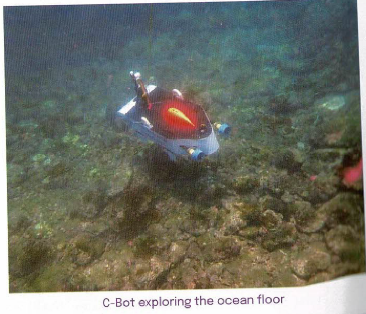
- India embarked on polar explorations, with its maiden voyage to Antarctica in 1981 and the establishment of research stations Dakshin Gangotri, Maitri, and Bharati.
- Studies covered geology, chemistry, atmosphere, biology, glaciology, and more. India also initiated Arctic explorations in 2007, focusing on atmospheric, biological, marine, earth sciences, and glaciology research.
Indian Research Vessels
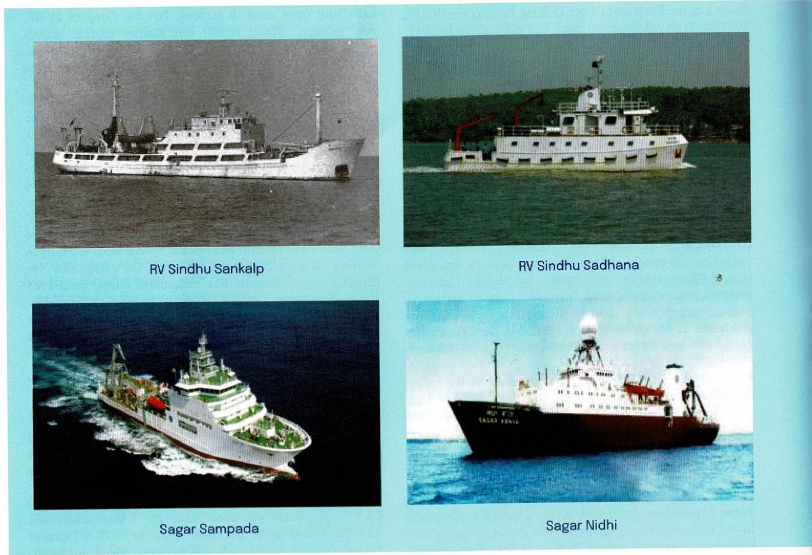

- India’s first research vessel, RV Gaveshani, was launched in 1975.
- Subsequent vessels like CRV Sagar Sukti, RV Sindhu Sankalp, and RV Sindhu Sadhana furthered oceanographic research.
- The MoES operates a fleet of ships, including ORV Sagar Kanya, FORV Sagar Sampada, and others, facilitating extensive oceanographic studies.
Major Marine Geological Projects
- The CSIR-NIO and the Marine and Coastal Survey Division (MCSD) have conducted significant marine geological projects.
- Research on placer mineral deposits, polymetallic nodules, and seamounts has been crucial.
- India was recognized as a Pioneer Investor by the International Sea-Bed Authority (ISA) in 1987 and continued to explore areas like the Central Indian Ocean Basin.
- The Deep Ocean Mission and investigations into the Krishna-Godavari Basin for methane gas hydrate deposits highlight India’s commitment to marine research.
Conclusion
- India’s oceanographic research has evolved significantly over the decades, involving extensive collaborations and cutting-edge projects.
- The nation’s contributions to marine science have positioned it at the forefront of oceanographic studies, providing valuable insights and support to various countries.
ARTICLE 6
Sustainable Land Management: Harmonising Human Needs with Ecology
Overview
- Land degradation and desertification are critical global issues, affecting not only land productivity but also water quality, human health, and ecosystem stability.
- These processes disrupt key ecological functions, such as the global carbon, hydrogen, and nutrient cycles, leading to severe ecological and economic consequences like soil erosion, famine, floods, and depletion of natural resources.
- Environmental and Economic Consequences
- The ecological fallout includes reduced carbon absorption capacity and increased greenhouse gas emissions, which exacerbate climate change.
- This in turn leads to erratic weather patterns, including frequent and severe droughts, flooding, rising temperatures, and sea levels.
- The economic repercussions include diminished livelihood options, increased outmigration, and heightened human-wildlife conflicts.
Extent and Impact of Land Degradation
Global Scale
- Land degradation affects over 2.6 billion people and impacts nearly 29% of the world’s land.
- Each year, approximately 24 billion tons of fertile soil and 27,000 species are lost worldwide. While arid regions are most affected, 80% of degradation occurs elsewhere, demonstrating its widespread nature.
Case Study: India
- In India, 29.77% of the land (97.85 million hectares) is degraded, primarily due to water erosion, vegetation degradation, and wind erosion.
- States like Jharkhand, Rajasthan, Delhi, Gujarat, and Goa face severe degradation, affecting more than 50% of their land.
- These trends necessitate national action plans to combat desertification and land degradation.
Global and National Initiatives
UN Decade on Ecosystem Restoration
- The United Nations has launched the Decade on Ecosystem Restoration (2021-2030) to address interconnected issues of land degradation, climate change, biodiversity loss, inequality, and poverty.
- Key global initiatives include the United Nations Convention to Combat Desertification (UNCCD), the United Nations Framework Convention on Climate Change (UNFCCC), the Convention on Biological Diversity (CBD), and Disaster Risk Reduction (DRR).
Sustainable Land Management (SLM)
- Sustainable Land Management (SLM) emerged as a goal from the 1991 United Nations Conference on Environment and Development.
- SLM promotes the sustainable use of land resources to meet human needs while maintaining environmental functions.
- Strategies include Integrated Landscape Management, resource management, and soil and water conservation.
India’s Commitment
- India has pledged to restore 26 million hectares of degraded land by 2030 under the Bonn Challenge. Initiatives like the Green India Mission and the Nationally Determined Contribution (NDC) aim to enhance forest cover and sequester additional carbon.
- Over 700 million rural Indians depend on forests and agriculture, underscoring the importance of these measures.
Sustainable Land Management Practices in India
Traditional Practices
India has a rich history of SLM practices that have maintained land fertility and health. Examples include:
- Rice Fish Farming in Arunachal Pradesh: Utilizes excellent water supply for dual cultivation of rice and fish.
- Zabo Farming System in Nagaland: Integrates agriculture, fisheries, horticulture, forestry, and animal husbandry with soil and water conservation.

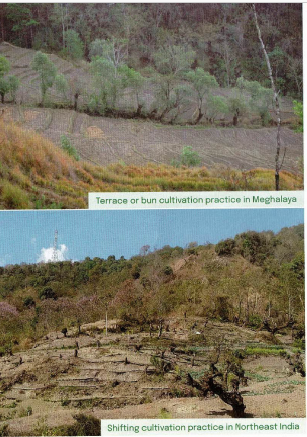
- Bamboo Drip Irrigation in Meghalaya: Efficiently manages irrigation in mountainous terrains.
Innovative Techniques
Innovative practices continue to evolve:
- Artificial Glaciers in Ladakh: Divert water to shaded areas to create artificial glaciers, providing irrigation during warmer months.
- Bhungroo Technique in Gujarat: Artificially recharges aquifers to store rainwater, lowering underground water salinity for agricultural use.
- Johads in Rajasthan: Small check dams that harvest rainwater and recharge groundwater.
The Future of Sustainable Land Management
Emerging Trends and Innovations
- Future advancements in SLM will be driven by new technologies and methods.
- Precision farming, remote sensing, and biotechnology promise to increase land productivity while reducing environmental impacts.
- By embracing innovative solutions, promoting public education, and practicing responsible land stewardship, we can ensure a sustainable future where human needs and ecological conservation coexist.
ARTICLE 7
Interference of Invasive Species on Achieving SDGs in India:
Introduction to the Sustainable Development Goals (SDGs)
- In 2015, the United Nations member states unanimously adopted the 17 Sustainable Development Goals (SDGs) during a summit in New York City, USA.
- As we approach the ninth year since their adoption, it is crucial to evaluate the progress made in implementing these goals.
- This evaluation focuses on key challenges such as eradicating poverty, achieving zero hunger, ensuring clean water and sanitation, preserving life on land and below water, and addressing climate change.
- The COVID-19 pandemic has significantly impacted progress, but even before the pandemic, the UN was dissatisfied with the pace of implementation, urging member states to accelerate their efforts.
Monitoring and Progress in India
- In India, NITI Aayog plays a vital role in tracking the progress of states and Union Territories (UTs) towards achieving the SDGs. NITI Aayog prepares national reviews for presentation at the UN High-Level Political Forum.
- The latest progress report from NITI Aayog indicates that all Indian states have surpassed 50 points in SDG implementation. Notably, 15 states are in the front-runner category, demonstrating significant improvement nationwide.
- However, some goals, such as gender equality and zero hunger, remain in the aspirant category, and climate action needs considerable advancement.
- NITI Aayog has emphasized the need for aggressive implementation at all levels to avoid adversely affecting the country’s overall performance.
The Challenge of Invasive Alien Species (IAS)

- A significant, yet often overlooked, challenge to achieving the SDGs is the impact of Invasive Alien Species (IAS).
- IAS are major drivers of global biodiversity loss and pose threats to food security by damaging agriculture and aquaculture production.
- Despite their importance, there is limited quantitative information in NITI Aayog’s reports on IAS interference with SDG implementation.
- IAS directly affect ten of the 17 SDG goals. In India, there is inadequate understanding and management of IAS, which impacts biodiversity, livelihoods, health, GDP, and SDG progress.
- Research on IAS in India is minimal compared to other countries, with only about 150 studies available before 2000.
- There is a lack of involvement from organizations and universities in pan-India IAS research.
Steps Toward Addressing IAS
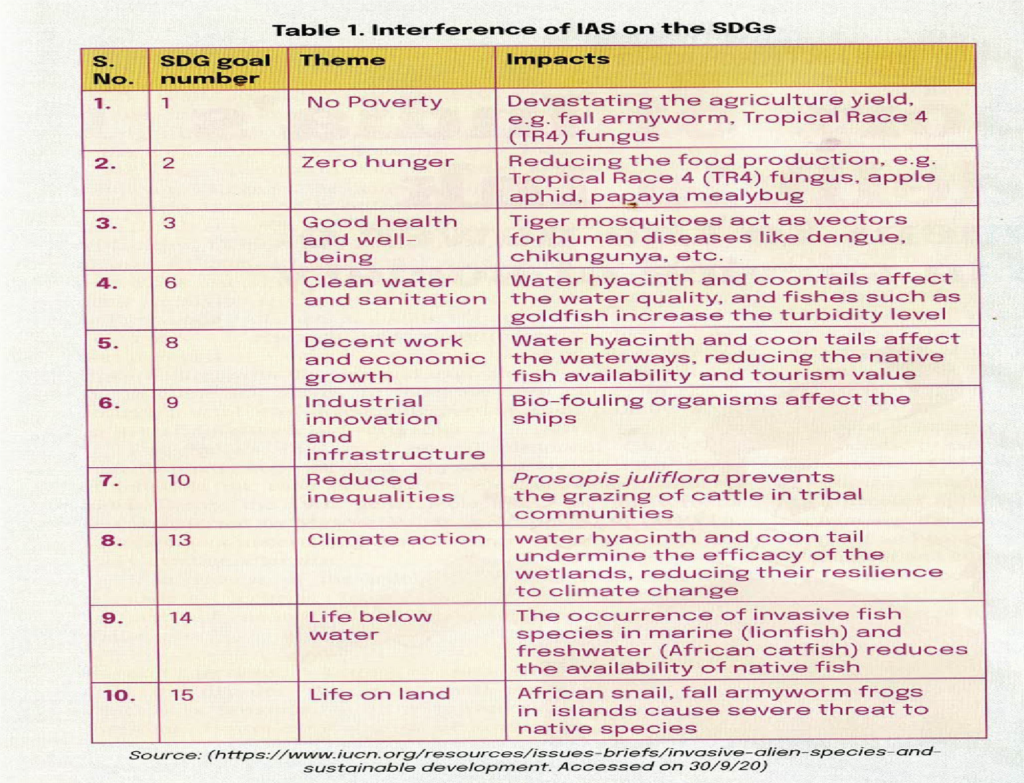
- In 2017, the National Biodiversity Authority (NBA) formed an 18-member expert committee on IAS, which published a report in 2018.
- However, updated information has not been available since then. The Convention on Biological Diversity (CBD) includes IAS in its strategic plan for biodiversity 2011-2020 (Aichi Target 9) and urges signatories to address IAS.
- A recent CBD report highlights progress in identifying and prioritizing IAS but notes insufficient development in pathway identification, management, and control.
- As a CBD signatory, India must adhere to CBD guidelines, which can aid in achieving the SDGs.
Role of the Centre for Biodiversity Policy and Law (CEBPOL)
- The NBA, through the Centre for Biodiversity Policy and Law (CEBPOL), has been proactive in addressing IAS issues by establishing a national-level committee and publishing reports, research articles, and awareness materials.
- The NBA can further educate State Biodiversity Boards (SBBs) and Biodiversity Management Committee (BMC) members on IAS issues.
- This grassroots-level education is crucial for achieving SDGs, as without addressing IAS, India cannot meet its CBD and UN targets within the stipulated period.
ARTICLE 8
The Story of India’s Indelible Ink
Top of Form
The Birth of Indelible Ink in India
- In 1950, as India began its journey as a democracy, ensuring free and fair elections was a significant challenge due to concerns about fraudulent voting.
- The Council of Scientific and Industrial Research (CSIR) took on the task of finding a scientific solution to safeguard the electoral process.
- The Ink Development Unit (IDU) at the CSIR-National Physical Laboratory (CSIR-NPL), led by Dr. Salimuzzaman Siddiqui, initially focused on manufacturing postal stamping ink but soon shifted its efforts towards developing an “Indelible Ink” to prevent double voting.
Development and Implementation of Indelible Ink
- Years of research and experimentation led to the creation of a unique ink based on silver nitrate.
- This ink, when applied to the skin and exposed to ultraviolet light, left an indelible deep purple mark, symbolizing a citizen’s participation in the electoral process.
- For India’s first two general elections, CSIR-NPL produced approximately 3 lakh liters of this ink for the Election Commission of India.
- By the 1962 general elections, the ink formula was transferred to Mysore Paints & Varnish Ltd (MPVL), a government undertaking, which has since supplied the ink for all subsequent elections.
Global Impact and Legacy of Indelible Ink
- The success of indelible ink in securing India’s elections was immediate and caught the attention of many other nations facing similar challenges.
- The formula remained unchanged over the decades, underscoring its effectiveness. CSIR-NPL’s spirit of innovation persisted into the 21st century, exploring uses of luminescent inks for anti-counterfeiting, medical diagnostics, and forensic applications.
- The potential for integrating microchips or QR codes within the ink suggested a future where a single drop could hold extensive information, further enhancing security.
Innovations and Future Directions
- CSIR-NPL’s indelible ink has been embraced by 35 countries worldwide. The technology was transferred to MPVL through the National Research Development Corporation (NRDC), with CSIR-NPL continuing as a technical consultant.
- This collaboration highlights a commitment to upholding democratic values globally.
- CSIR-NPL’s ongoing research focuses on developing advanced pigments for currency notes, stamp papers, passports, and other critical documents to enhance security.
Advanced Pigments and Invisible Inks
- One area of research involves developing pigments capable of emitting multiple colors under different light sources, adding a layer of security against counterfeiting.
- Another focus is on invisible inks, which are detectable only under specific light conditions, offering specialized solutions for document and currency authentication.
- These innovations demonstrate CSIR-NPL’s versatility and commitment to advancing scientific knowledge to protect democratic processes.
The Collaborative Power of Innovation
- The partnership between CSIR-NPL and MPVL exemplifies the power of collaboration in driving innovation and addressing global challenges.
- By combining expertise and resources, these organizations contribute to protecting democratic processes worldwide.
- The indelible ink serves as a beacon of hope, illustrating the power of innovation to create a more secure democracy for all.
ARTICLE 9
Gir: The Last bastion of Asiatic Lions
Introduction to Gir National Park
- Gir National Park, also known as Sasan Gir, is part of the Khathiar-Gir dry deciduous forests ecoregion.
- It is located in Gujarat, India, 43 km northeast of Somnath, 65 km southeast of Junagadh, and 60 km southwest of Amreli.
- Established in 1965, Gir covers an area of 1,410.30 square kilometers, with 258.71 square kilometers designated as a fully protected national park and 1,151.59 square kilometers as a wildlife sanctuary.
- Historically, Gir was the royal hunting grounds before being converted into a national park to protect its unique biodiversity, especially the Asiatic lions.
Habitat and Ecology
- Gir National Park’s terrain includes rugged hills, scrub jungles of teak and ziziphus, and large open patches of grassland intersected by several perennial rivers.
- The semi-dry climate supports tree species such as teak, dhak, khair, ber, babul, and jamun.
- These trees are crucial for maintaining the natural habitat and ecological balance, providing an ideal environment for lions and their prey.
- Besides lions, Gir is home to a variety of animals, birds, and reptiles, making it a vital ecosystem.
Population and Conservation of Asiatic Lions


- As per the 2015 Asiatic Lion Census, approximately 600 Asiatic lions inhabit Gir Forest. Traditionally, the pugmark technique was used to estimate lion populations, relying on the unique footprints of each lion.

- In 2020, due to COVID-19 restrictions, a new method called “Poonam Aviokan” or “observation on a full moon night” was introduced for the census.
- Historically, Asiatic lions were widespread across regions like Afghanistan, Iran, and the Arabian Peninsula but are now confined to Western India.
- The 19th-century hunting expeditions by Indian rulers and British colonists nearly drove them to extinction.
Challenges and Human-Lion Conflicts
- With an increasing lion population, conflicts with humans have escalated. Lions require extensive territories, and human encroachment into their habitats has led to several conflicts.
- The Gujarat Forest Department’s 2020-21 report highlighted the death of 12 people and injuries to over 70, along with approximately 4,000 cattle casualties.
- Additionally, in 2018, several lions died due to canine distemper virus and other causes. High-voltage electric fences used by locals to protect crops have also led to lion fatalities.
Conservation Efforts and Policies
- To mitigate these threats, the “Vanya Prani Mitra” program was launched to monitor wild animal movements in villages near Gir.
- A cash reward program for reporting poaching activities was also introduced.
- Recognizing the risk of disease or natural disasters wiping out the entire lion population, the “Project Lion” initiative was launched in 2020 to reintroduce lions to other parts of India.
- Under this initiative, Barda Wildlife Sanctuary, 100 km from Gir, will be developed as a second home for lions.
Future Prospects and Ongoing Efforts

- Efforts to protect lions include removing hazardous electric fences and constructing walls around open wells.
- Increased awareness and conservation measures are showing positive results, with the lion population in Gir now healthier than a century ago.
- The forest department’s initiatives and continued efforts aim to restore the lions’ population and habitat, ensuring the survival and prosperity of these majestic creatures.
- With these sustained efforts, the Asiatic lions are poised to regain their past glory and continue to thrive in their natural habitat.
ARTICLE 10
Blue Carbon: Why it is Important
Varied Forms of Carbon
- Carbon, often perceived as a deep black material, exists in nature as several allotropes with different colors.
- Graphite is grey-black, amorphous carbons like soot and lamp black are black, diamond is colorless, and fullerenes range from yellow to brown. Inorganic carbons also exhibit various colors.
- Recently, a color-based description of organic carbon has emerged, highlighting its properties and distribution.
- Blue, green, and teal carbon emphasize its role in climate change mitigation through sequestration, while black, brown, and red carbon relate to Earth’s heat balance or the promotion of cryospheric melting.
The Importance of Blue Carbon
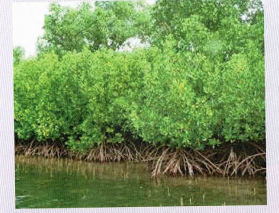
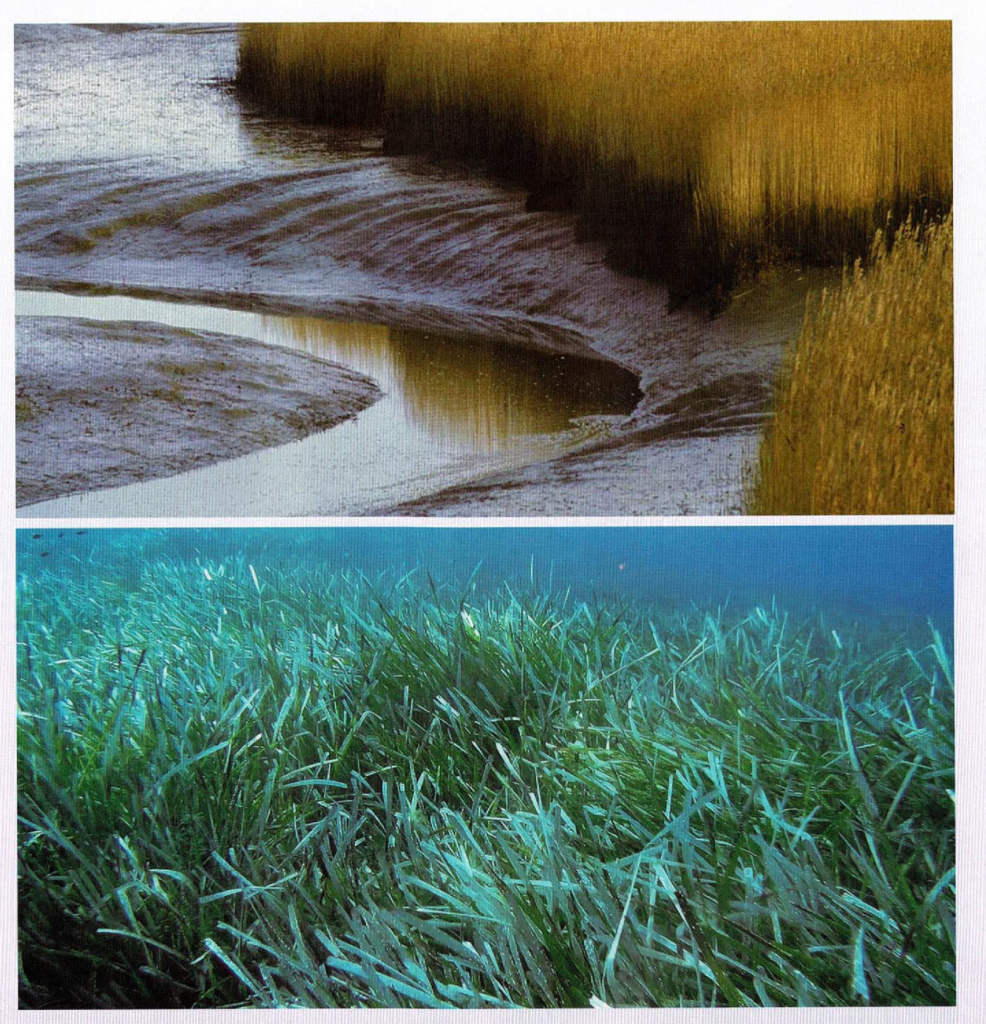
- Blue carbon refers to the carbon sequestered by oceanic environments such as mangrove forests, salt marshes, and seagrasses.
- These ecosystems are among the most productive globally, growing extensively each year and sequestering significant amounts of carbon.
- Their anaerobic soils slow down decomposition, allowing carbon to be stored for thousands of years.
- Approximately 33 billion metric tonnes of carbon are currently stored in blue carbon ecosystems, which provide benefits such as storm protection, shoreline erosion prevention, water quality regulation, and habitat provision for marine species.
Distribution and Ecosystem Services

- Blue carbon ecosystems are found along the coasts of every continent except Antarctica.
- Mangroves are prevalent in the inter-tidal zones of tropical and subtropical shores, while tidal marshes are common in temperate zones.
- Seagrass meadows, consisting of underwater flowering plants, are present in coastal waters worldwide.
- These ecosystems sequester carbon at impressive rates, with mangroves sequestering carbon 56 times faster than tropical forests.
- They play a crucial role in climate change adaptation and provide essential services to coastal communities.
Threats to Blue Carbon Ecosystems
- Despite their importance, blue carbon ecosystems are rapidly depleting due to human activities. Rising carbon dioxide levels and global warming are exacerbating the issue.
- An estimated 340,000 to 980,000 hectares of these ecosystems are destroyed annually. Significant portions of mangroves, tidal marshes, and seagrass meadows have been lost in recent decades.
- If this trend continues, a substantial portion of these ecosystems may vanish in the next century, releasing large amounts of stored carbon dioxide and contributing to global warming.
Conservation Initiatives
- Efforts to save and restore blue carbon ecosystems are underway. The International Blue Carbon Initiative focuses on conserving and restoring coastal ecosystems for climate, biodiversity, and human well-being.
- This initiative promotes scientific research, policy development, and sustainable projects to improve coastal community livelihoods.
- Projects like the Delta Blue Carbon project in Pakistan and the Magdalena Bay Blue Carbon Project in Mexico are protecting and restoring vast areas of tidal ecosystems.
Blue Carbon in India
- India is recognized as a “blue carbon wealth recipient country” but has yet to fully utilize this resource.
- Tamil Nadu’s blue carbon initiative leads efforts to spread awareness and offer lessons on the importance of blue carbon ecosystems.
- Learning from successful organizations in renewable energy, India is looking to establish a dedicated organization for blue energy sectors, aiming to harness the potential of blue carbon for climate change mitigation.
ARTICLE 11:
Tropical Root and Tuber Crops Treasures from the Soil
Introduction to the Underground World of Plants

- The lush green canopy of plants that covers the Earth is more than just a beautiful sight; it is essential for providing the oxygen we breathe.
- Leaves act as the plant’s food factories through the process of photosynthesis.
- However, the often-overlooked underground world of plants, especially the roots, plays a crucial role in their survival and our sustenance.
- Roots anchor plants, absorb water and nutrients, and in legumes, assist in nitrogen fixation through a symbiotic relationship with Rhizobium bacteria.
- While the synthesized food is stored in various parts of plants, roots and tubers serve as vital storage organs, offering significant nutritional value to humans and animals.
Tropical Root and Tuber Crops
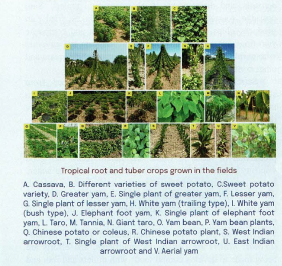
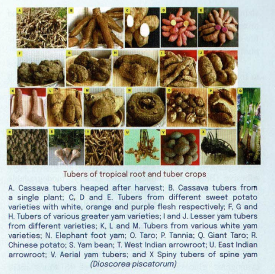
- Tropical root and tuber crops are indispensable sources of carbohydrates, second only to cereals, and play a crucial role in food security and income for resource-poor countries in the tropical region.
- These crops, including cassava, sweet potato, yams, and aroids, are resilient to climate variations and can thrive in extreme environmental conditions.
- They efficiently convert solar energy into high yields and possess excellent properties for various value-added products. These crops are often referred to as the “hidden treasures from the soil” due to their significant impact on the global economy and food security.
Diverse Varieties and Cultivation
- Tropical root and tuber crops are diverse, belonging to various plant families and exhibiting a range of habitats.
- Cassava, for example, grows well in dry laterite soils, while taro thrives in swampy or marshy conditions.
- These crops are propagated clonally or vegetatively, and most are polyploids, meaning they have multiple sets of chromosomes.
- This diversity in cultivation practices and adaptability to different environmental conditions highlights their importance in ensuring food security, especially in marginal and extreme conditions.
Nutritional Value
- Root and tuber crops are rich in carbohydrates and produce significant dry matter.
- Cassava, for instance, is a staple food in many developing nations due to its high carbohydrate content. Sweet potatoes are notable for their protein, dietary fiber, vitamins, minerals, and antioxidants.
- Yams offer a rich source of carbohydrates, proteins, lipids, and essential minerals.
- These crops, especially yams, are considered superfoods due to their high nutritional value. Despite their rough appearance, they provide essential nutrients and play a vital role in dietary diversity and health.
Industrial Uses and Value-Added Products

- Cassava and sweet potato have extensive industrial applications. Cassava is used to produce starch, bioethanol, feed, medicine, and biopolymers.
- Its starch is utilized in food industries for making various products and in non-food industries for manufacturing adhesives, textiles, and biodegradable plastics.
- Sweet potato offers a wide range of edible items and industrial products, including alcohol, beverages, and bioethanol.
- The industrial utilization of these crops demonstrates their economic importance and potential for innovation in various sectors.
Pharmaceutical Applications
- Root and tuber crops also have significant pharmaceutical applications. Cassava starch is used in tablet manufacturing, while sweet potato has antidiabetic properties and is rich in antioxidants.
- Yams contain diosgenin, a source of steroidal hormones, and have various medicinal properties. Lesser yams and elephant foot yams are used to treat gastrointestinal disorders and other health issues.
- The pharmaceutical potential of these crops adds to their value, making them essential in both traditional and modern medicine.
Conclusion: Future Potential
- As climate change poses challenges to food production, tropical root and tuber crops offer a promising solution due to their high yield, nutritional richness, and adaptability.
- These crops are crucial for food and nutritional security, especially in low-income countries.
- While often underutilized, they serve as primary raw materials for various industries and are essential for small-scale farmers and tribal communities.
- The hidden treasures of starchy tubers beneath the soil are vital for sustaining our future food supply and ensuring global food security.
ARTICLE 12
A Tiny Fish Loud as a Gunshot
Discovery and Unique Characteristics

- Danionella cerebrum is a tiny aquatic marvel found in the streams of the Bago Yoma Range in Central Myanmar.
- Despite its minuscule size, measuring only 10-13.5 mm in length, it can produce sounds louder than a gunshot.
- Discovered in 2021, this species has the smallest known adult vertebrate brain and is nearly transparent, making it an invaluable subject for neuroscience studies.
- Its close resemblance to Danionella translucida led to previous misidentifications. These fish belong to the same family as zebrafish, a common model organism in scientific research.
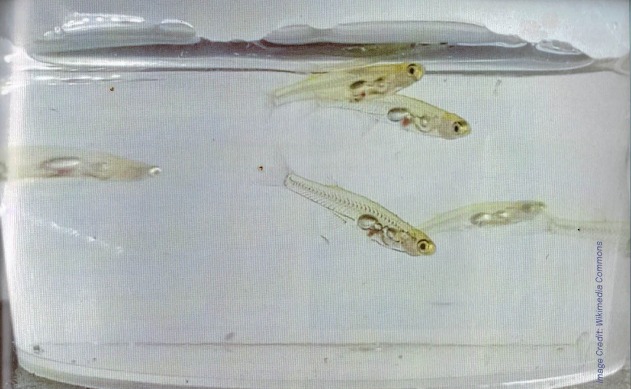
Sound Production Abilities
- Researchers at the Einstein Center for Neuroscience were puzzled by clicking noises coming from fish tanks housing Danionella cerebrum.
- They discovered that male Danionella cerebrum can emit sounds exceeding 140 decibels, comparable to the intensity of a gunshot.
- Even at a distance of three feet, the sound remains as loud as car horns or symphony orchestras.
- This remarkable sound production capability led scientists to investigate further.
Anatomical Mechanisms
- Advanced techniques revealed a unique sound production apparatus within Danionella cerebrum.
- The fish has a specialized propulsion mechanism involving a drumming cartilage, a specialized rib, and a fatigue-resistant muscle.
- The muscle contracts, pulling the rib and loading the cartilage with stress. When released, the cartilage strikes the swim bladder, producing a loud sound.
- This process is rapid, with each pulse lasting only four-hundredths of a second, and the pulses are strung together in sequences with variable gaps.
Comparison with Mantis Shrimp
- The sophisticated actuation mechanism of Danionella cerebrum is reminiscent of the mantis shrimp’s punching apparatus.
- The mantis shrimp uses a spring-release mechanism to deliver powerful blows, similar to how Danionella cerebrum produces its loud sounds.
- Danionella cerebrum boasts one of the highest ratios of loudness to body size among animals, surpassing elephants, whales, songbirds, and bats, and is exceeded only by certain insects like fruit flies.
Potential Functions of Sound Production
- The exact purpose of Danionella cerebrum’s sound production remains unclear. Scientists speculate that the sounds may aid in navigation in murky waters or serve as a means of social communication among competing males.
- Observations indicate that only some males produce the sounds, and the loudness varies among individuals. The high-pitched sounds, with frequencies in the kilohertz range, could be effective for communication or navigation in low-visibility environments.
- This discovery of Danionella cerebrum’s extraordinary adaptation enhances our understanding of animal motion and communication.
NEWS IN BRIEF
1) India’s first mobile Medical Devices Calibration facility

- The Indian Institute of Technology Madras (IIT Madras) has introduced India’s first ‘medical devices calibration facility on wheels’ to ensure the proper functioning of medical devices through timely maintenance.
- This mobile facility aims to provide affordable and accurate calibration services, which are essential for precise disease diagnosis and treatment. It is designed to operate across India’s diverse terrains, including mountains, deserts, and forests, thereby extending quality healthcare to remote areas.
- Researchers highlight that this initiative will reduce calibration and transportation costs and the time required, marking a significant advancement towards accessible, scalable, and high-quality healthcare for everyone.
2) IIT Guwahati Pioneers Groundbreaking Speech Reconstruction Technology

- RESEARCHERS at the Indian Institute of Technology Guwahati have achieved a significant breakthrough in speech technology by developing and patenting “LOQU”, a novel method to generate human speech signals directly from vocal cord vibration signals.
- This technology captures vocal fold movement without invasive procedures, utilising sensors placed over the throat.
- This approach allows for the reconstruction of speech signals from vocal cord vibrations, offering promising applications for speech-impaired individuals and medical settings.
- According to the researchers, the reconstructed speech signals are clear and comparable to traditional speech in extensive comparison tests.
- Additionally, these results hold significant potential for individuals struggling with speech impairments, offering a viable alternative to traditional microphones and enhancing speech clarity.
3) New plastic coating discovery gives greater functionality to 3D printing

- Researchers from the University of Nottingham have developed a new coating for plastic particles used in 3D printing to address the functionality limitations of current polymers.
- Using supercritical carbon dioxide, they created an efficient, effective, and clean process to coat PA-12 polymer particles.
- This coating not only enhances the printing process but also adds color and anti-mould and fungal properties.
- Moreover, the new process can be easily integrated into existing commercial 3D printing setups. This advancement has been published in Nature Communications.
4) Sodium Battery — Charges in Just a Few Seconds

- Researchers from the Korea Advanced Institute of Science and Technology (KAIST) have developed a high-energy, high-power hybrid sodium-ion battery capable of rapid charging within seconds.
- Existing sodium-ion batteries suffer from lower power output, limited storage, and longer charging times.
- The new hybrid system combines anode materials used in batteries with cathodes suitable for supercapacitors, resulting in high storage capacities and rapid charge-discharge rates.
- This innovation positions the hybrid sodium-ion battery as a promising alternative to lithium-ion batteries. The research was published in Energy Storage Materials.


